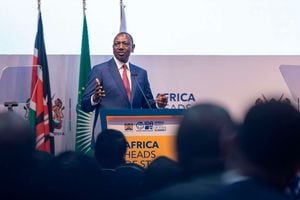Activists betrayed Lang’ata school children
What you need to know:
- The children’s sentiments were packaged to echo the ones of those bent on criticising the government.
- Through carefully crafted messaging on placards, the children were not just asking for their playground, they were accusing the government of protecting land-grabbers, amplifying synonyms of revolution and in some cases, bringing into question the political choices of their parents.
- Against the backdrop of the public outcry, the political vehicle that was the children morphed into a runaway train whose momentum the organisers harnessed and capitalised on to sling mud at the government.
If you were not outraged by the teargassing of the Lang’ata Road Primary School children, then a part of your humanity is missing.
In what can only be described as a tragic convergence of reckless, overzealous activism and poor police training, Kenyans were left struggling to understand how primary school children could be subjected to the brutal force that is synonymous with the quelling of riots.
One cannot condemn enough the brazen conduct of the policemen involved, and the government has reflected these sentiments in reprimanding the concerned individuals.
However, as the blame game continues, it is vital that we scrutinise the latent objectives of the architects of the demonstration.
The duplicity of the organisers of the protest march can be seen in the messages on the placards the children were carrying. These were not the sentiments of any six- or 12-year-old, or any child, for that matter.
The children’s sentiments were packaged to echo the ones of those bent on criticising the government. The organisers, having little or no regard for the potential violence that could erupt, insouciantly placed children in harm’s way in a bid to tug at the heart strings children inevitably strum.
The children were unwitting pawns in the tactics of those opposed to the government. The organisers knew that the children would receive unbiased support from the public.
ACCUSING THE GOVERNMENT
Through carefully crafted messaging on placards, the children were not just asking for their playground, they were accusing the government of protecting land-grabbers, amplifying synonyms of revolution and in some cases, bringing into question the political choices of their parents.
Any enthusiasm (from the children) for these petitions on the placards would have been uninformed and manufactured in the midst of the unfamiliar hysteria.
These were simply not the voices of the children. They had not been consulted beforehand and educated on the spirit of the demonstration and were, consequently, unaware of the fact that they were being used to propagate a certain narrative.
The organisers roped “playgrounders” into their political agenda. This was a case of activism abusing its power and the trust of children, exploiting an already exploited and vulnerable group without its informed consent.
The use of teargas literally added gas to the motif of the organisers and brought tears to the innocent children.
Against the backdrop of the public outcry, the political vehicle that was the children morphed into a runaway train whose momentum the organisers harnessed and capitalised on to sling mud at the government.
Parallels were drawn with the egregious Soweto massacre. Visuals were juxtaposed to entrench in our minds the similarities of a violent apartheid regime with that of a democratically elected government.
A society is ultimately judged by how it treats its weakest and most vulnerable members. Children fall into this group and have an innate trust for adults. It is this trust that the organisers of the demonstrations grabbed and channelled to play their “gotcha” politics.
The writer is a political communications consultant. ([email protected])





